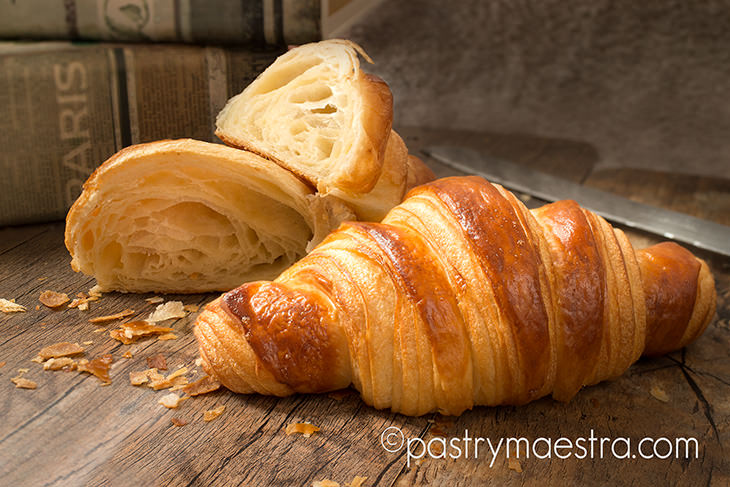W
arm, flaky croissants [kʁwa.sɑ̃], some extra butter and jam on the side, coffee and freshly squeezed orange juice, and all that served on a rooftop terrace in Paris, overlooking the Eiffel Tower. Now that’s the breakfast of champions! But, have you ever wondered how to make croissants?
Croissant Dough vs. Puff Pastry
Croissants are made of laminated dough. There are two main differences between classic puff pastry and croissant dough:
- Puff pastry doesn’t contain any yeast while croissant dough does.
- To make puff pastry, you need to make 5 single turns, and to make croissants, you need only 3 single turns.
- One more important thing, if you want your croissants perfect, you will need at least 2 days to make them. First you need to make your yeast dough and chill it overnight. On the second day you need to make the turns, and after the dough rests, you can start making croissants.
Origin of Croissants
The origin of the croissant is, like it usually happens in the history of gastronomy – unknown, or, to say the least – undefined. However, it seems that all the historians agree that the predecessor of the croissant was kipferl,a crescent shaped Viennese cookie traditionally made from ground nuts. BTW, if you want to learn how to make kipferl, also known as vanilla crescents, check my post about it. Now, about the legends regarding the origin of croissants. There are many, but I will name just a few. According to one, kipferl was invented in Europe to celebrate the defeat of the Umayyad Calpihate forces by the Franks at the Battle of Tours, France in 732, with the shape representing the Islamic crescent. Another legend tells a similar story, only it happened in 1683 – allegedly, some baker from Vienna, Austria, while the city was under siege by the Ottomans, heard their soldiers digging a tunnel to penetrate the city, and called the military who collapsed that tunnel and saved the city. So, to celebrate the defeat of the Ottoman forces, they created the crescent shaped cookie and named it kipferl.
Fast forward to 19th century, and we have yet another story claiming that there was an Austrian artillery officer, August Zang who in 1838 or 1839 founded a Viennese bakery (“Boulangerie Viennoise”) in Paris, France and served Viennese specialties including the kipferl that was made with noticeably flakier dough than traditional and the French changed its name to “croissant'” – in French that means “crescent”. Now, it is important to emphasize that this was not a croissant that we know and love today, because it was not made of puff pastry at all! BTW, if you want to learn how to make a really good puff pastry, check my post. Now, various recipes for croissant appeared in the years after Zang’s bakery opened, but the first one to refer to a croissant based on puff pastry was a French baker named Sylvain Claudius Goy, who wrote a recipe in 1915 that specifically mentions puff pastry with yeast! Finally, a star was born! Nothing more to tell, so, let’s honor the memory of great chef Goy and make some yummy croissants right now!

Croissants Recipe
by:Tereza Alabanda,The Pastry Maestra
PRINT PDF (EN) ISPIŠI PDF (HR)Prep. time : 2 days
Cook time : 15-20 minutes
Ready in 2 days
Level : Advanced
Ingredients:- Manitoba flour 250g (8.8oz)
- All purpose flour 250g (8.8oz)
- Salt 15g (1Tbsp)
- Sugar 60g (2.1oz)
- Water 140g (5oz)
- Milk 140g (5oz)
- Fresh yeast 25g (0.9oz)
- Butter, softened 50g (1.8oz)
- Butter for laminating 300g (10.6oz)
- Put all the flour, salt, sugar, and fresh yeast into a bowl of a stand mixer fitted with hook attachment. Add cold water and milk and mix on medium speed for a couple of minutes.
- Wrap the dough in a plastic film and leave it in the refrigerator overnight to rest the gluten and develop the taste.
- Put the butter in the middle of parchment paper sheet, and fold the sheet into 15cm x 15cm (6″ x 6″) square. Pound the butter with a rolling pin, and roll it out to fit the square. It should stay cold but manageable, and it should be the same consistency as the dough.
- Roll the dough in 30cm x 15cm (12″ x 6″) rectangle. Place the butter in the middle of the dough and fold the rest of the dough over the butter, so it covers the butter completely.
- Press the dough with a rolling pin carefully and roll it slowly, so the butter spreads evenly inside the dough.
- Fold the dough in thirds (this is called single turn), wrap it in foil and put it in the fridge for 15 minutes.
- Roll the dough again maintaining the shape of regular rectangle, brush off the excess flour and make one more turn. Cover the dough and put it in the refrigerator to chill. Repeat the procedure one more time. For croissants, there are three single turns.
- Roll the dough into 50cm x 20cm (20″ x 8″), and approximately 5mm (1⁄5“) thick rectangle. Using your small knife, make a mark every 10cm (4″) on one side of the rectangle. On the opposite side make the first mark at 5cm (2″), and then every 10cm (4”). Cut uniform isosceles triangles with a pizza wheel.
- Gently stretch each triangle with your hands, and then roll, starting from the base of the triangle towards its top. Place croissants onto a paper lined baking tray.
- Brush them with egg wash and proof at lower temperature – approximately 27°C (80°F) for about 2 hours, because the higher temperature will melt the butter. I usually put my croissants in the cold oven, and without turning the oven on, place a plate filled with hot water on the bottom of the oven. Then I close the door and leave croissants to prove for 2 hours. Before baking brush croissants with egg wash once more.
- Bake them at 180°C (350°C) for about 20 minutes, until golden.
Copyright© PastryMaestra.comTM
Well, what do you think about this post?
Please leave your comment on YouTube, thank you!
I read and really appreciate all the comments, even though I do not always have the time to respond to each one. So – keep me in the loop and try to create some sweetness every day because – Sweetness is happiness!!




